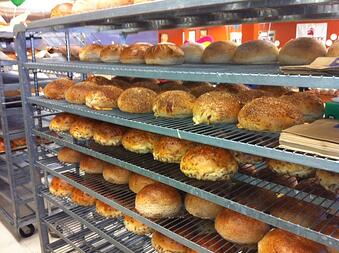And I am going to subtitle this “without telling you to shop in Whole Foods even once.” I will also not tell you to buy only organic food. Curious?

Let me start with the premise. I want to know where my food comes from. I want to eat a healthy diet in line with one I’ve outlined in previous posts (here and here). And I want to not go broke. How do I do that?
The Everyday Person’s Guide to Real Food, Realistically
There is a common misconception that eating real food is expensive or inconvenient. Neither is true, as long as your standard for convenience isn’t the McDonald’s drive thru.
On its surface, my approach may seem simple, but it's certainly not intuitive in today’s Big Food world. Please, feel free to ask questions in the comments section. And, realize that the most important step to doing this is to get into the right habits.
Farm to Table Does Not = Local
First, let me make something clear. To me, farm to table and eat local are very different things. Local is what it is. It means that my food came from a source within a reasonable distance (defined differently in different situations) from where I buy it. Farm to table means that I know where it came from, but it might be from afar. For example, our wheat is local to the northern Rockies but it is not for the rest of the country. Yet it is still farm to table because we know the growers and it goes directly from them to our bakeries.
Join a CSA and Build Your Menus Around What Shows Up
To eat farm to table, one must have a plan. Mine is to eat what is fresh from local specialty food stores so that I know what I am eating and where it came from. My wife and I belong to a CSA that is in season about 40 weeks of the year. The rest of the year I go to a local specialty market for my produce and fruit. In either case I shop first, menu plan second. That really is the key. See what shows up on my doorstep and then build a menu around it.
The second thing I do is shop at an old school, local butcher shop. I know the animals are either sustainably raised or organic. I buy what fits my vegetables but we only eat meat about once a week at home so this is an easy trip. Our primary proteins are eggs and tofu, which I get at a normal grocery store.
Lastly, we eat a lot of whole grains. I buy my bread from you know where. I buy my pastas from a local Italian market that makes their own whole wheat pasta. Quinoa and rice noodles are things I just buy from a grocery store.
 And Just Like That, Dinner is Now a Community Affair
And Just Like That, Dinner is Now a Community Affair
This doesn’t have to be hard and it sure can be fun. So, this is what my grocery shopping looks like, in sum:
- I get a box of veggies and fruits from my CSA every other week. That’s easy enough; I don’t have to do anything there. I plan our meals around that.
- I make a run to the market district once a week to hit my butcher shop and specialty stores. Assuming I’ve planned well, it’s simple enough to get in and out with what I need.
- I go to my normal grocery store once a week for household/pet items and fill in the gaps in my menu. Since I already have most of my food, this is a quick trip.
It really is that simple and can be summed up with “Join a CSA and then build a menu from there with an eye toward a local butcher shop and bakery.” We can get 95% of our food that way and know where it came from.
A few more tips:
• For the traveler, get an App called Happy Cow. It is basically Yelp for vegetarians and local foods.
• Buy a cookbook called Cooking the Whole Foods Way by Christina Pirello. It is a bible for this lifestyle.
• Understand you don’t have to buy everything organic. Choose to buy organic where it really matters. If it is a fruit or veggie and you take the outside off (banana or orange or peeled squash) then you are okay. If you eat the skin (broccoli or grapes) think more about where it is has been. In my home, we pay particular attention to our beef in terms of how it is raised.
To Make it a Bona Fide “Experience” − Do Your Own Leg Work
I said I wasn’t going to say “just shop at Whole Foods,” and I didn’t. But you could. Everything I suggest here can be accomplished by going to Whole Foods. And I do at times, but honestly it isn’t as satisfying.
The produce section there doesn’t give me the option to drive out to my CSA’s farm and meet the family. The meat section, if you really look at it, isn’t especially healthy. Most of the products are a 1 on their 5-step scale for rating animal welfare, and that is really just a step above normal. Why pay a premium for that? Their bakery isn’t, well…. Their seafood section is very good. But, all in all, I prefer to do the work myself and join the CSA, drive to see my local butcher, and support my local baker. I turn shopping into as much of an experience as I do cooking…
How do you do farm-to-table and/or local in your neck of the woods? Let us know in the comments about any great local foods you’re using and about your relationship with your food and the people who supply it.
Read more about real food and farm to table in these other posts:
- Get To Know the Farms in the Farm-to-Table Movement
- Farm to Table: My Own Vegetable Garden
- Real Food Resolutions for the New Year
- It’s Time to Eat Real Food and Support National Food Day





